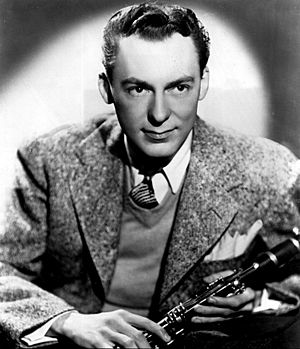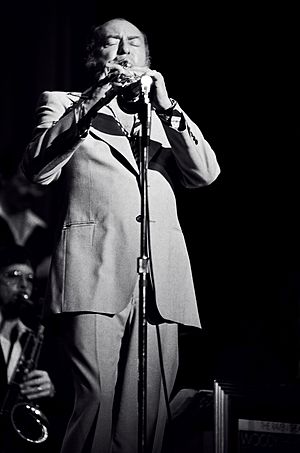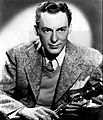Woody Herman facts for kids
Quick facts for kids
Woody Herman
|
|
|---|---|

Herman in 1943
|
|
| Background information | |
| Birth name | Woodrow Charles Herman |
| Born | May 16, 1913 Milwaukee, Wisconsin, U.S. |
| Died | October 29, 1987 (aged 74) West Hollywood, California, U.S. |
| Genres | |
| Occupation(s) |
|
| Instruments | |
Woodrow Charles Herman (born May 16, 1913 – died October 29, 1987) was an American jazz musician. He played the clarinet and saxophone and was also a singer. Woody Herman was most famous for leading his own big bands, which he called "The Herd." He became well-known in the late 1930s and continued making music until he passed away in 1987. His bands often played new and exciting music, and they won many awards.
Early Life and First Steps in Music
Woody Herman was born in Milwaukee, Wisconsin, on May 16, 1913. His parents were Otto and Myrtle Herrmann. His dad loved show business, which inspired Woody from a young age. As a child, Woody performed as a singer and tap-dancer in shows. By the time he was 12, he started playing the clarinet and saxophone.
In 1931, he met Charlotte Neste, who wanted to be an actress. They got married on September 27, 1936. Woody Herman joined the Tom Gerun band, and his first recorded songs were "Lonesome Me" and "My Heart's at Ease." He also played with other orchestras, including Isham Jones's band. When Isham Jones decided to stop leading his band, Woody Herman took over, starting his journey as a bandleader.
The Band That Played the Blues (1936–1943)
Woody Herman's first band became famous for playing blues music. People sometimes called them "The Band That Plays The Blues." They recorded for Decca Records. Their first song, "Wintertime Dreams," was recorded in November 1936.
After two and a half years, the band had its first big hit, "Woodchopper's Ball," recorded in 1939. Woody Herman said it was a "sleeper" hit because it became popular slowly over several years. Eventually, it sold more than five million copies, making it his biggest hit ever! In 1942, his song "Blues in the Night" (where he sang) became a number one hit on the Billboard charts. Other popular songs from this time included "Blue Flame" and "Do Nothin' Till You Hear from Me."
The First Herd and New Sounds (1944–1946)
In 1944, Woody Herman formed a new group called the First Herd. This band was known for playing a new style of cool jazz. Their music was influenced by famous jazz artists like Duke Ellington and Count Basie. They mixed bebop ideas with swing rhythms, which many people loved.
In February 1945, the band started recording with Columbia Records. Their first song for Columbia was "Laura," from a 1944 movie. Woody Herman's version was so popular that Columbia decided to hold back a version recorded by another famous musician, Harry James.
The First Herd had many talented musicians, including Sonny Berman, Pete Candoli, and Ralph Burns. They recorded the hit song "Caldonia" in 1945.
In 1946, Woody Herman's band was voted the best band by many music magazines like DownBeat and Metronome.
A famous classical composer, Igor Stravinsky, even wrote a special piece for Woody Herman's band called the Ebony Concerto in 1945. Herman's band performed this piece live at Carnegie Hall in March 1946.
Even though the band was very successful, Woody Herman decided to break up the orchestra in 1946. He wanted to spend more time with his family. Many people say that December 1946 was when the big-band era started to end, as many other bands also stopped playing around that time.
The "Four Brothers Band" and Other Herds (1947–1969)
In 1947, Woody Herman started a new band called the Second Herd. This group was also known as "The Four Brothers Band." This name came from a song called "Four Brothers," which featured four saxophone players: Zoot Sims, Serge Chaloff, Herbie Steward, and Stan Getz.
This band had hits like "Early Autumn." Woody Herman and his band even appeared in the 1947 movie New Orleans with jazz legends Billie Holiday and Louis Armstrong.
Woody Herman continued to lead different versions of his band, including the Third Herd (1950–1956) and other groups in the 1960s. He was known for finding and hiring talented young musicians. In the 1960s, his music started to be influenced by rock and roll. He also sometimes used instruments not usually found in jazz, like the bassoon or French horn.
The "Young Thundering Herds" (1970–1987)
In the early 1970s, Woody Herman traveled a lot and started teaching jazz to younger musicians. Because of this, he earned the nickname "Road Father," and his bands were called the "Young Thundering Herds."
In 1973, Woody Herman was one of the performers at the Super Bowl VII halftime show. In 1974, his band played for Frank Sinatra's TV special The Main Event. In 1976, a special concert was held at Carnegie Hall to celebrate Woody Herman's 40th anniversary as a bandleader.
By the 1980s, Herman's music returned to a more traditional jazz style, but he also mixed in rock and fusion sounds. He signed with Concord Records around 1980.
Timeline of Woody Herman Bands

Last Years and Legacy
Woody Herman kept performing into the 1980s, even after his wife passed away and his health declined. He had to keep working to pay back taxes. This was a lot of stress, but he continued to play music.
Before Woody Herman died in 1987, he asked Frank Tiberi, who led the reed section, to take over his duties. Frank Tiberi still leads a version of the Woody Herman orchestra today. Woody Herman passed away on October 29, 1987, and was buried in the Hollywood Forever Cemetery in California.
Woody Herman's orchestras won many awards from major music publications:
- Voted best swing band in the 1945 DownBeat poll.
- Won the Metronome poll for best band in 1946 and 1953.
A documentary film called Woody Herman: Blue Flame – Portrait of a Jazz Legend was released in 2012 to honor him.
Gold Records
Woody Herman's band earned "Gold Records" for selling many copies of these songs:
- 1939: Woodchopper's Ball (instrumental)
- 1945: Laura (vocal by Woody Herman)
Grammy Awards
Woody Herman and his bands won several Grammy Awards for their music.
| Year | Nominee / work | Award | Result |
|---|---|---|---|
| 1963 | Encore: Woody Herman, 1963 | Best Jazz Performance – Large Group (Instrumental) | Won |
| 1973 | Giant Steps | Best Jazz Performance – Large Group (Instrumental) | Won |
| 1974 | Thundering Herd | Best Jazz Performance – Large Group (Instrumental) | Won |
In 1987, Woody Herman also received a special Grammy Lifetime Achievement Award for his amazing career in music.
| Year | Nominee / work | Award | Result |
|---|---|---|---|
| 1987 | Woody Herman | Lifetime Achievement Award | Inducted |
Other Awards and Honors
- He has a star on the Hollywood Walk of Fame.
- The Woody Herman Music Archives were created at the University of Houston School of Music in 1974.
- He received an honorary doctorate degree from Berklee College of Music in 1977.
Images for kids
See also
 In Spanish: Woody Herman para niños
In Spanish: Woody Herman para niños




